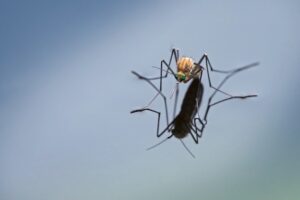How to Keep Mosquitoes out of Your Pond: DIY Tips
Mosquitoes disrupt outdoor enjoyment and pose health risks due to their potential to transmit disease. Ponds can inadvertently become breeding grounds for mosquitoes. This comprehensive guide will explore various strategies to teach you how to keep mosquitoes out of your pond.
How to Keep Mosquitoes out of Your Pond
There are multiple ways to keep mosquitoes out of your pond. Each tip can work on its own but is much more effective when used together.
- Which fish you can introduce to help eat mosquito eggs
- How to keep the water moving to discourage egg laying.
- How you can set up mosquito dunks.
- What plants to add to repel mosquitoes.
- Cleaning tips to keep your water fresh.
- Water level tips.
Introduce Mosquito-Eating Fish:
The Natural Predators
Introducing mosquito-eating fish is one of the most effective and environmentally friendly methods to control mosquito larvae. Species like Gambusia affinis, commonly known as mosquito fish, and certain minnow varieties are known for their voracious appetite for mosquito larvae. These natural predators establish a balanced ecosystem, reducing mosquito populations organically.
Choosing the Right Species
Before introducing fish to your pond, it’s crucial to choose the right species that are compatible with the existing aquatic life. Research different options and consult with local experts to ensure a harmonious environment for fish and other pond inhabitants.
Install Aeration Systems:
Disrupting Stagnation
Mosquitoes thrive in stagnant water, making aeration systems crucial for mosquito control. Fountains, bubblers, and other aeration devices circulate pond water, disrupting stagnant conditions that mosquitoes favor. Beyond mosquito prevention, aeration enhances water quality, benefiting the overall health of aquatic life. Mosquitoes are attracted to and breed in any standing water, including small puddles, stagnant ponds, ditches, and even in containers like flowerpots, bird baths, and gutters.
Types of Aeration Systems
Choose an aeration system that suits the size and depth of your pond. Consider options such as surface aerators, diffused aerators, or fountain aerators. Each type serves a specific purpose, ensuring proper oxygenation and water movement.
Use Mosquito Dunks:
The Power of Biological Larvicides
Mosquito dunks are an effective biological control method containing Bacillus thuringiensis israelensis (Bti). This bacteria targets mosquito larvae, rendering them incapable of maturing. Safe for humans, pets, and other wildlife, mosquito dunks provide targeted control without harming the pond ecosystem.
Proper Application
To maximize the efficacy of mosquito dunks, follow the recommended application guidelines. Distribute them strategically across the pond, focusing on areas prone to mosquito breeding. Regular use ensures continuous prevention throughout the mosquito breeding season.
Maintain Proper Water Levels:
Discouraging Breeding Conditions
Mosquitoes prefer still water for breeding. Maintaining proper water levels in your pond and preventing overflow or stagnation creates an environment less conducive to mosquito egg-laying. Regularly inspect and address any drainage issues that may lead to water accumulation.
Seasonal Adjustments
Be mindful of seasonal changes that may impact water levels. Monitor your pond closely during heavy rainfall and adjust water levels as needed. Proactive management prevents potential breeding opportunities during wetter periods.
Clean Debris Regularly:
Eliminating Breeding Sites
Mosquitoes often lay their eggs on the surface of standing water, attaching them to floating debris. Regular pond cleaning is essential to remove leaves, twigs, and other organic matter that can accumulate. This not only eliminates potential breeding sites but also improves the overall aesthetic appeal of your pond.
Routine Maintenance
Incorporate routine maintenance into your pond care schedule. Regularly remove debris, check for clogged drains, and trim overhanging vegetation. Consistent upkeep minimizes the risk of mosquito infestation and ensures a healthy pond environment.
Use Mosquito-Repellent Plants:
Harnessing Natural Deterrents
Certain plants possess natural mosquito-repelling properties, adding an extra layer of defense to your pond. Consider incorporating citronella, lavender, and marigolds around the pond perimeter. These enhance the visual appeal of your outdoor space and act as natural mosquito deterrents. For readers in Florida, check out our blog on native plants to repel mosquitoes.
Strategic Plant Placement
Strategically place mosquito-repellent plants near areas prone to mosquito activity. This includes pond edges, seating areas, and pathways. The aromatic properties of these plants create a pleasant ambiance while discouraging mosquitoes from approaching.
Conclusion:
Creating a mosquito-free pond involves a holistic approach that combines natural strategies with proactive measures. Introducing mosquito-eating fish, installing aeration systems, using mosquito dunks, maintaining proper water levels, cleaning debris regularly, and incorporating mosquito-repellent plants can transform your pond into a harmonious environment free from mosquito breeding. Enjoy the tranquility of your oasis without the buzzing annoyance of mosquitoes, and relish the beauty of a well-maintained, mosquito-free pond.


